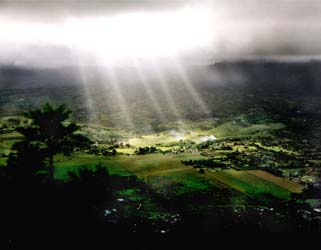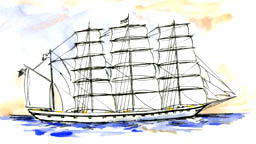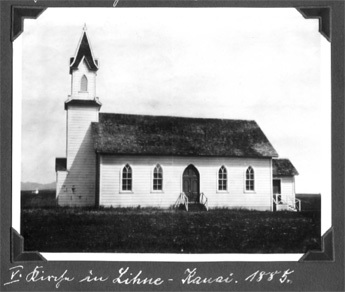 |
A Voyage
to Hawaii in 1881 Kaua'i, Hawaii by Charles Kiesel |
 |
A Voyage
to Hawaii in 1881 Kaua'i, Hawaii by Charles Kiesel |
The following description of the voyage
from Germany to Hawaii in 1881 was written by Charles Kiesel (b.
1876 Nienburg, Ger. d. 15 Jan 1949 Santa Barbara, CA) but left
unfinished after 5 pages. Others who have seen this
document describe it as handwritten.
Written by Charles Kiesel in Hawaii 1939
As I sit in the old rocking chair in my comfortable little cottage in beautiful ___Valley my gaze sweeps over the green clad mountains, through, through the open window drifts the interesting pefume of moak oranges and many other flowers and shrubs which are in full bloom although it is winter here in Hawaii. A gentle invigorating breeze sweeps down through the Palu in which sway the tall blossom laden Mango trees and Cokoanut Palms. The hum of the honey bees complaining can be heard from where I am sitting by the window as they buzz from flower to flower gathering the sweet nectar, yes this is indeed the paradise of the Pacific or the garden of Eden that it was when I first saw the Island 58 years ago back in the fall of 1881.
My mind travels back over the years to a time when I was just a boy 5 years old. At the time my father, mother, four brothers and one sister were living in a little cottage in a village near the Weser River in Germany, well do I remember the little garden with all sorts of fruit trees and berries and how my father and I spent each Sunday in the garden for this was the only day he could spend among the flowers and fruit trees. The rest of the week he worked hard in a glass factory for a small salary barely enough to support the family and I often heard him say, if only I could find a way so we could all go to some new country where we could make a better living and have more freedom than here. His prayers were answered for one day he came home all excited waving
Page 2
a piece of paper in his hand saying we are off for the Sandwich Islands and we have two weeks in which to get ready. I have just signed a five year contract with H. Hakfeld & Co. who are agents for some sugar plantations and are going to the Island of Kauai which I am supervising planting a forest. They will also advance the passage money for the whole family which is to be deducted from my salary over the contract period. Also in the contract they agree to furnish subsistence for the whole family, house, fuel , water and all the food we can eat. In all there will be 150 immigrants, men, women, children. They will be distributed among the Sugar Plantations of which H. Hakfeld are the agents. The ship on which we will sail is now anchored at the river port of Genste Munde. All were very excited that there was very little sleep that night. Next day my mother started packing each day a little more was added to the trunk and boxes. My father went out and bought hams, bacon, sausage and a tub of butter and several large loaves of pumpernickel (dark rye bread) which were all packed in a separate box to take with us. So just in case, well I’ll tell you more about that late.
Finally the eventful day arrived when all trunks and boxes were loaded and sent down to be put aboard. My mother dressed me in my best clothes, got all the rest of the children ready and we started down to where the black hull of a full rigged sailing vessel was lying at anchor in mid stream. Friends were at the pier to bid us all bon voyage and we were soon hustled aboard. The ship was a double decker apparently constructed for immigrant service. On the main deck near the galley on both port and starboard large casks of water were secured
Page 3
to the deck. She had a four foot railing built of solid oak except aft where and officers Quarters were located. Three brass bound steps posrt and starboard led to the poop deck where the Captain stood. Holes were cut in the railing even with scuppers to disgourge the heavy seas which she might take over the side. Above the scuppers extra mast and spars laid in cradles which was securely lashed to the railing. In standing on these masts I could just get my head and arms above the railing. Forward under the deck house steps led down to the lower deck, bunks three tiers high with a partition every six feet and eighteen inches high separated these bunks which ran along the wall of the ship both port and starboard, the upper bunks were just about a foot below the port holes, one place aft was reserved for more casks of water and baggage for the immigrants. I got an upper bunk where I could look through the porthole at the head of my bunk. In her lower hole, she carried a cargo of coal for Honolulu, (Capital of the group of islands). That evening we were served a splendid meal under the supervision of the agents, the last decent meal we were to get for the next six months for the captain turned out to be a cutthroat and scoundrel. We all went to our bunks happy that night for we had been told that in three months time we would be in sight of the islands but that we might encounter some heavy weather going around Cape Horn for this was the winter season in the north Atlantic. Next morning we could hear a commotion on deck shouting and running I scrambled out of my bunk and as soon as I was dressed my father took me on deck where already a number of immigrants were assembled to watch the raising the anchor the first mate a huge brute that resembled more a gorilla than a human being was shouting orders while the sailors were going round with their hand on capsen bars singing at the top of their voice the old familiar shanty (we are bound for the rio grande) yard after yard of which the heavy anchor chain was being taken in. The heavy lines had been made fast and as soon as the anchors were secured the tug gave a blast with her whistle and slowly we headed down the river. Shortly before lunch the steward came below and told all single men and heads of families to assemble on deck to be addressed by the captain and given instructions. The captain a tall heavy set man with graying beard and moustache stood on the poop deck looking down upon the men gathered around. Men said he we have a long voyage, ahead of us, and we will not touch any port until we reach Honolulu, it will take us perhaps two weeks round Cape Horn and we may encounter heavy storms for this is the winter season in the Atlantic ocean. We will have to conserve food and water in order to complete the trip and there will be an allowance of one quart of water of each family per day and a pint for each single man, salt water will be used for washing clothes and if a bath is required it must be done in salt water and now the steward will hand you your mess kits. Each head of family was given a coffee pot a small bucket
page 5
also a panican, spoon and tin cup for each member of the family. They were also told at eight bells (the number 12:00) to line up at the galley and receive food for their families. At eight bells my dad took his bucket and coffee pot and lined up, he was soon back with a half bucket of pea soup in which floated eight small pieces of salt pork, one black hard tack for each member of our family and a can of coffee sweetened with a little trickle and it was so thin you could plainly see the bottom of the tin cup. The hard tack was alive with weevle and had to be first soaked in the hot coffee in order to soften it and remove the weevle that I think was the only reason that we received coffee on each meal on the whole trip. Late that afternoon the ship started to pitch and roll and we heard shouting and singing on deck my dad and I went up to see what was going on, sailors like monkeys were going up the rope ladder making their way out on the spar foot ropes loosening the sails which were tied to the spars. The mate shouting orders while the sailors were tugging at the lines singing a shanty as sail after sail went up and bellied out in the stiff breeze. The tug had let go and blew the whistle as a fare well, soon the ship heeled over on her side and rode more steady as she headed into waves we were on our way. The ship had ceased rolling but was pitching as she rode the heavy seas. There was a commotion below nearly all the women and biggest part of the men and some of the children were down with sea sickness those that were not affected had to play nursemaids as there were no nurses or doctors aboard.
[story courtesy of Ken Benner, http://www.vastbranches.com]
Transcription of the handwritten , barely started, history
of his voyage. It takes us through his life in before and into
the start of the voyage. Also references trouble with the
captain and food shortages discussed in the Blackstad's
account
_____________________________________________________________________________________
 An unbelievably vivid
description of the voyage of the Cedar can be read in the
letter of Jensen Blackstad to his grand daughters.
An unbelievably vivid
description of the voyage of the Cedar can be read in the
letter of Jensen Blackstad to his grand daughters. By 1882 the workforce of Lihu'e plantation was up to 245. It consisted of 76 Chinese, 60 South Sea Islanders, 55 Hawaiians, 43 Germans and 11 Norwegians. Around 1885 pineapple plantations were started in Hawaii. In 1898 the sugar planters were able to convince the United States to annex Hawaii as a possession in spite of some native opposition. They knew that they would then receive a special payment for shipping sugar to the mainland. The islands eventually became a territory of the United State on June 14, 1900.
The German families here formed a strong community. They built their own church and established their own school on the Lihu'e Plantation with an imported German teacher. Fredrich Richter, a theology student who came on the first boatload, was not only the teacher but also the minister for the Lutheran congregation. The German language was spoken and taught for many years in both the school and the church.

The school was operating until 1918 when the United States went to war and the Isenburgs were urged to close the school. At that time there were still thirty-five students. Through these institutions the culture and traditions of Germany were undoubtedly kept intact on Kaua'i. Records were kept of all the births of the early immigrants and are now in the Hawaii state archives. Very few of these immigrant families remain in Kuau'i today except through intermarriage with the native Hawaiians, Portuguese, Norwegian or other nationalities. Many of the families immigrated to the mainland to Washington, Oregon and California by the early 1900's as did most of my Kiesel and Schock families.
source:







All information and
photos included within these pages are here for the express
purpose of personal genealogical research and may not be
included or used for any commercial purpose or included in
any commercial site without the express permission of Cheryl
and Elroy Christenson. Copyright Elroy Christenson
1998-2016.